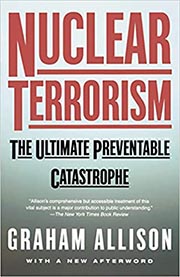Nuclear Terrorism : The Ultimate Preventable Catastrophe
by Graham Allison
Reviewed April 4, 2005
 The issue of nuclear terrorism is not a new one to the world community. In 1995, we published an example scenario of a terrorist-detonated nuclear weapon in the heart of New York City. That scenario was based on a complete stolen device, however the ingredients for a nuclear device - fissile nuclear material - are easily available. In many cases this material is not carefully guarded nor accounted for. The technology is not very complicated, and a graduate-level physics student would have the necessary science background to develop a weapon.
The issue of nuclear terrorism is not a new one to the world community. In 1995, we published an example scenario of a terrorist-detonated nuclear weapon in the heart of New York City. That scenario was based on a complete stolen device, however the ingredients for a nuclear device - fissile nuclear material - are easily available. In many cases this material is not carefully guarded nor accounted for. The technology is not very complicated, and a graduate-level physics student would have the necessary science background to develop a weapon.
Nuclear weapon states are now up to eight with Iran and North Korea on the verge of joining the nuclear club. Terrorists are also striving to acquire and then use nuclear weapons. The proliferation of nuclear weapons is one of the greatest threats that the world faces.
A founding dean of Harvard's John F. Kennedy School of Government, Graham Allison's Nuclear Terrorism addresses all the big questions: who could be planning an attack; how might they acquire a device; and how such a weapon could be delivered.
Allison explores biological and chemical attacks, but focuses on the stronger nuclear threat: non-nuclear radiological bombs ("dirty bombs") and traditional nuclear devices. To put this danger into perspective, a chemical, biological or radiological attack would kill in the thousands. A 15-kiloton nuclear bomb could kill up to one million people.
Allison provides several examples of a nuclear explosion on New York City, San Francisco, Houston, Washington DC, Chicago, Los Angeles, and Charlotte, North Carolina.
After painting a bleak picture of the real possibility of nuclear terrorism, the book turns to provide solutions. He lays out a systematic program of "three no's"
- no unsecured nuclear weapons
- no new countries capable of enriching uranium or reprocessing plutonium
- no more states with nuclear weapons
Allison also outlines "seven yeses" ways to provide solutions to this crisis. He argues that we must increase our funding and attention to programs like the Nunn-Lugar Nuclear Threat Reduction Program.
The book also presents a program to reduce the United States' vulnerability to a nuclear terrorist attack. Given that a retired four-star general, formerly in charge of the nuclear anti-terror programs at the Department of Energy stated, "It is not a matter of if, it's a matter of when."with respect to the chance of a terrorist attack with a nuclear device, this book should be read by everyone.